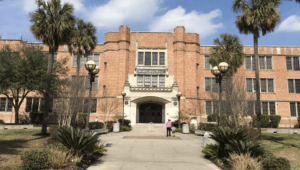What I Missed (Or Even Got Wrong)

“You think we are smart?” blurted one of the 6th graders. Two other heads swiveled around to listen. “I’m not!” declared one. “Why do you think we are smart?” asked the other.
Seeing my chance I enthusiastically declared, “Oh yeah! You are definitely all smart. I’ve only known you for a month and I can see that each of you are really smart and each of you have curiosity about different things.” I had learned by now that at most I would have five precious moments of their attention. “You know being smart starts with being curious and asking questions. But guess what, even if you are smart now, you can get even smarter when you exercise your brains by thinking hard.”
I began volunteering in a middle school in Santa Fe where 120 students who were not thriving in remote learning were invited back into school but not enough teachers elected to return. With incredible dedication, administrators, counselors, and a handful of teachers were scurrying to prepare for students in the schools and educators teaching from home. When the call went out for “internet cafe monitors,” I signed up. The core job is watching fifteen 6th graders take hour-long remote classes, play for 15 minutes, and then get them to refocus for their next class.
The first few days the kids were compliant little robots. The isolation of the pandemic and the experience of remote learning had knocked something out of them. Many students simply stared at their device for an hour straight and some sat at their desks barely moving even during break. Some had friends from their previous elementary school, some knew of each other, and some were meeting their peers for the first time. I redefined my job as an internet cafe monitor to include creating a sense of community, bringing a bit of fun, and building whatever trust I could with the limited time I had with them. Building relationships with them is paying off. My duties have expanded to include on-the-spot tutoring and coaching as the kids try to make sense of assignments, struggle with math, and learn to think for themselves.
This experience, just spending four hours a day with these 6th graders who have grabbed my heart, have made me realize a few things that I missed, underestimated, or got totally wrong in my days of writing for CompetencyWorks. Here are just a few:
Love
Teaching is about loving children. During a trip to Singapore years ago the director of a teacher training program had chuckled in response to the question, “What do you look for in teachers?” He replied, “Americans always ask that question. It’s very simple. We look for people who love children.”
I don’t think I mentioned love even once in all my writing and presentations about competency education. I think about all the time we spend on developing teacher competencies and defining what teachers should know and be able to do without ever mentioning love. However, we can’t stop with just mentioning how important it is. It requires us to think about what type of organizations we are building that values and nurtures love. I remember hearing Dorothy Stoneman, founder of YouthBuild, speak of the importance of love. I scribbled in my notebook: ‘How do we build bureaucracies of love?’
The question has always haunted me. I find it hard to imagine bureaucracies with all their top-downness being able to nurture love. Thus, my question today might be: Can we create a new form of organization that places loving children in the center while still being accountable to the public? Perhaps the answer can be found in New Zealand’s Tomorrow’s Schools effort to create autonomous schools?
Making System 2 Thinking A Habit
At times the chatter and questions feel like they are bombarding me. I do my best to respond to each of the kids. But under pressure, I often respond with quick answers rather than asking questions or engaging them to think with me. I don’t take the time to find out what is really going on behind their masked faces. And it’s just as likely as not that I make an assumption, likely influenced by biases, that is off the mark. And I see in their eyes that they’ve just shut down. And my heart breaks. Not only did I lose a chance to build trust, I may have just dinged them in a place that was already wounded.
By the end of second day I realized that my reliance on System 1 thinking was getting in my way. I’ve read Thinking Fast and Slow by Kahneman but had never tried to build my capacity to use System 2. Now it’s my number one skill-building effort. I chant to myself as I enter the school every morning, “Slow down. Ask more questions. Slow down. Ask more questions. Observe, observe, observe.” (Try it, you can turn it into a song!) I can’t say I’m operating in System 2 all day, all the time. But I’ve noticed that just asking students questions in response to their questions is changing the nature of our relationships and some are taking more responsibility. (This has been particularly effective when the boys want to lean back on two legs of their chairs. What do you think the pros and cons are of doing that? It’s more comfortable. It’s not safe and I could fall. Whadya want to do? And soon all four legs of the chair are back on the ground.)
I often talk about the importance of System 2 thinking as important in challenging bias and creating equitable classrooms. It’s that but so much more. It’s an essential skill for engaging students, building trust and creating an empowering classroom.
The Heartbreaking Experience of Gaps and The Fixed Mindset
It is way too easy to jump to the conclusion that a student doesn’t understand a new skill when in fact they are missing something they should have previously learned. It happened yesterday as I sat with a student as he worked through learning to test inequalities. He had several Ah-Ha! Moments with big smiles (or so I assumed given that he was masked) as he began to understand the the task and the meaning of the symbols ‘>’ and ‘<’. He cranked through several problems and then came to a quick stop when he encountered -5 > x. His growing confidence collapsed. I thought he was having troubles with the way the equation was structured with the x on the right. But that wasn’t it at all. It was negative numbers. If he had ever been taught, or learned how to work with negative numbers, it had all been forgotten. Promising to work with him again on the next day, I ran home to learn how to teach negative numbers using real life examples such as credit cards.
However, I’m not certain he will even be in school today. Will he be open to trying again? I don’t think I’ll ever forget the look on his face when he thought he understood but then couldn’t do the problem.
I’ve always said that students need to be able to get help on the same day, not several days later. However, I always meant it in terms of the importance in terms of achievement and the momentum of learning. What I didn’t understand is that every day we let a student stumble over a gap without helping them identify it and fill it, we are letting the pain of the fixed mindset dig in even deeper.
The Student Experience of Failure is Often Caused By the Little Things
One of the students that was simply going through the motions of school, having whispered to me at one point that he doesn’t like to think, had agreed to work on one of his overdue assignments in science to raise his grade. However, the circle map had remained empty as he stared at his computer for 10 minutes.
I sat down and we stared at the circle map together. As I asked questions to help figure out the assignment it dawned on me that the teacher had not left any directions or prompts. An exercise that was done in class was impossible to do outside of class without directions. And the student was assuming it was his fault that he couldn’t understand. It was a small thing until it wasn’t.
Later that day a math teacher had made a small mistake in his introductory inequalities practice questions that caused havoc for the students. His numbering merged with the questions turning x>3 into 2x>3 and x<-20 into 3x< -20—problems beyond what the students had been taught. Students that had thought they understood were stopped in their tracks. Suddenly paper airplanes were flying, negotiations started about trading snacks, and chairs were tipping again. Anything other than face the fact that they couldn’t do the work and once again were not feeling very smart.
Although I quickly figured out the problem, the momentum that they could tackle the inequalities had dissipated. Trust in themselves had taken a big hit.
At CompetencyWorks we often talked about the value of teacher collaboration often in the context of aligning instruction and assessment. But I underestimated how important daily collaboration is on making sure we are providing students with every opportunity to learn. Small mistakes on the part of adults can get in the way of learning and even contribute to students disengaging from learning. If I had to do it all over again, I would emphasize much more strongly that teachers need to be in constant partnership with each other including checking over each other’s work to avoid these tiny mistakes that cause immeasurable pain for students. We all know that operational excellence is to be found in the small things. We need to design operations so that it is easy for adults to catch those itty bitty mistakes that have an exponentially larger impact on our kids.
To date, my main takeaway from this experience is the fragility of trust. It’s not just about building trust. Trust can also be broken. The nature of trust is that it crackles, breaks, and bursts in a blink of an eye. And it takes intentional effort to repair it. I now consider trust as a scarce resource that requires daily investment and careful monitoring. Just like a bank account, it can go up and down quickly.
In just the way that we need to be able to deeply understand how beliefs about white supremacy get passed on, embedded in personal dynamics, and concretized in our systems in order to meet the goals of diversity, equity, and inclusion, we need to understand how adults disengage from students and break trust with children, usually unintentionally, in order for us to to create trust-rich learning communities where all kids soar.
There is a lot we can do to invest in trust building. It starts by valuing high quality relationships in a school. If learning is a social process that requires high quality relationships then we have to design the school for relationships. Yet our schools, schedules and staffing patterns often fail to fully take it into consideration. In addition, if we consider time as a resource, much more of it needs to be dedicated to relationship building. Finally, teachers that can build strong and enduring trust-generating relationships need to be honored with recognition and salary increases as do those that seek to build their instructional and assessment skills through continuing education.
For more, see:
- Finding Your Entry Point to Mastery Learning
- Mastery Learning in Action
- Shining the Competency Education Light on Education in the Time of COVID-19
Stay in-the-know with innovations in learning by signing up for the weekly Smart Update.








Terri Rowenhorst
Thank you for this refreshingly honest reflection on what matters most. This year has reminded us of many things we may have forgotten to keep at the center.